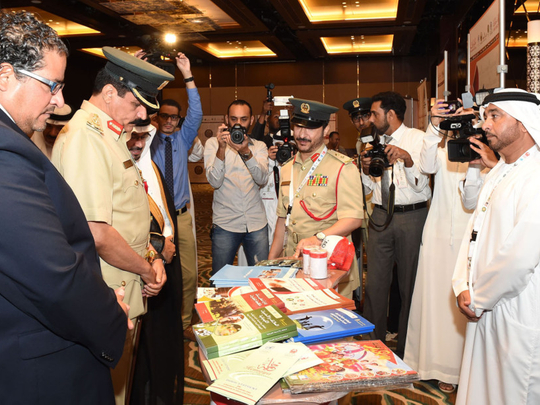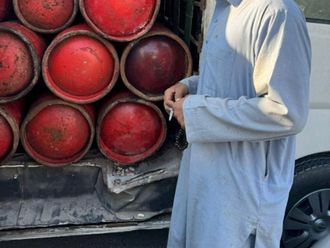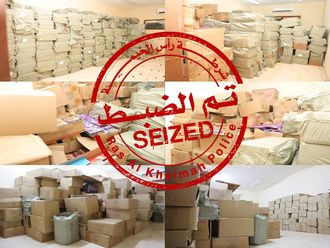
Dubai: The demand for amphetamine type stimulants (ATS), which include captagon, has seen a significant increase across the world in the past few years, helped by political instability in the Arab region, experts said at a conference on Monday.
Statistics from the United Nations Office on Drugs and Crime (UNODC) report showed a 21 per cent increase in methamphetamine seizures in 2014, 16 per cent in amphetamine seizures and 12.2 per cent in ecstasy seizures worldwide.
Speakers at Dubai Police’s 12th Hemaya international forum on drug issues on Monday also said that captagon production has become a profitable business for terrorist organisations.
Lt Gen Khamis Mattar Al Mazeina, Dubai Police Chief, said the forum this year will be dealing with the problem of amphetamines and stimulants, especially captagon, by bringing together officials and experts.
“Despite international and national efforts by governments and institutions, the problem lies in the lack of an integrative framework, as combating the demand and combating supply are two separate strategies. This creates large gaps exploited by international drug traffickers to spread their poison,” he said.
Col Abdul Rahman Al Owais, deputy director of the Federal Directorate General of Drug Combating in the Ministry of Interior, said the UAE seized almost 12 million captagon pills in 2015, an increase from just 2,501 pills in 2011.
“In the years between 2013 and 2015, we arrested a total of 169 people involved in captagon trafficking,” he said. Of these, 49 were Emiratis, 95 were Arab nationals, and 25 were from other nationalities, mostly Asians.
Col Al Owais said that political instability in the Arab countries has fuelled this increase in captagon production.
“Although there are some cases of captagon use in the UAE, the UAE is mostly a transit country that traffickers use to get the drugs to destination countries,” he said.
Drug traffickers attempting to smuggle drugs through the UAE resort to creative and advanced methods of concealment — which are expensive as they know there is tight scrutiny in the UAE. Some examples of these methods include hiding them in electrical cords, large water heaters, and wooden door frames.
Martin Raithelhubler, from the UNODC in Vienna, said that the ATS trafficking market is behaving very differently from all other drug trafficking markets in the past years.
“Other drugs [trafficking] have been increasing in the past 15 years, but not as dramatically. With some drugs like cocaine, we have even seen signs of stability in trafficking data, but when we look at ATS, there is a lot of ups and downs, and a recent peak.”
He explained that in 2014-2015 there was a large increase in ATS trafficking. “The ATS group of substances shows a dynamic situation…another reason to give attention to this group.”
He added that in the past, ATS did not feature prominently in drug seizures, but now it’s the second highest globally following cannabis which also puts a burden on law enforcement.
Captagon trade
Michelle Spahn, Country Attache at Drug Enforcement Administration, Dubai Country Office, said that captagon, the most popular ATS, has moved from being a minor illicit trade to a financial resource, especially for Daesh and Hezbollah.
“In the 1960s captagon was used to treat ADHD (attention deficit hyperactivity disorder), narcolepsy (a condition characterised by an extreme tendency to fall asleep whenever in relaxing surroundings) and depression,” she said.
She said that producing and trafficking captagon is very profitable as one pill, which costs around 29 cents to make, has a street value of between $3-$33 (Dh11.02-Dh121.21). “If we take an average of $10 per pill, and some high capacity captagon factories can produce two million pills per day, they stand to make a profit of $19 million.”
Labs have been found in Lebanon, Syria, Turkey and recently in Egypt.
In 2015, more than 310 million captagon pills were seized worldwide, a huge jump from 178 million the previous year.
However, she said, these statistics on seizures reflect only 10 per cent of actual amounts trafficked, as the data is collected through open source reporting.
The real number of captagon trafficked in 2015 could be estimated at around 3.1 billion, she noted.
“Our goal is to focus on chemical suppliers, which will enable law enforcement to restrict access for these organisations to precursor chemicals,” she explained.
Precursors are the raw materials — chemicals — that go into the manufacture of drugs.
“A lack of sources on captagon production, transportation and distribution within Syria — that is our main [intelligence] gap. How the proceeds from the sales of captagon get to Syria is another gap,” Spahn said.
She added that there also needs to be “a confirmation of the violent organisation that receive the captagon proceeds, suspected to be Hezbollah and Daesh, to fund their terrorist activities”.
“The way forward is we use a three-pronged approach, and this also applies to captagon trafficking investigations: awareness, prevention and enforcement. We cannot just rely on awareness and prevention, we need enforcement. We need to aggressively pursue these organisations,” she said.












